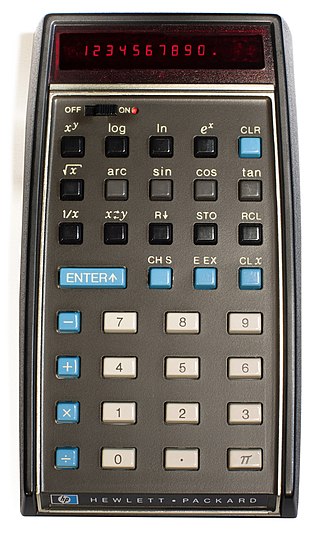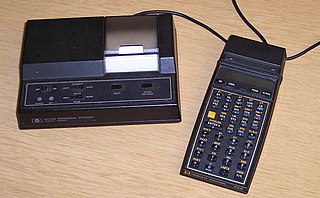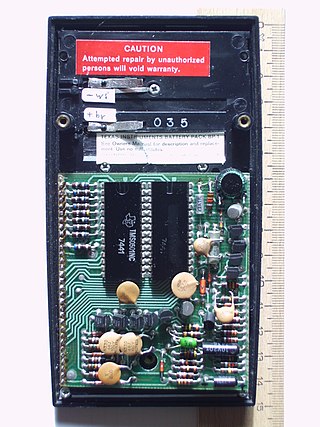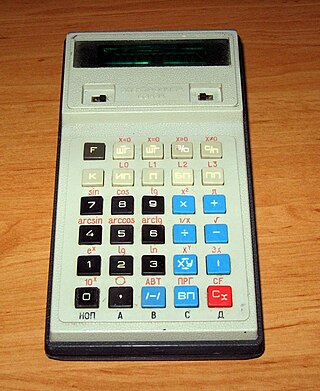Related Research Articles

An electronic calculator is typically a portable electronic device used to perform calculations, ranging from basic arithmetic to complex mathematics.
Reverse Polish notation (RPN), also known as reverse Łukasiewicz notation, Polish postfix notation or simply postfix notation, is a mathematical notation in which operators follow their operands, in contrast to prefix or Polish notation (PN), in which operators precede their operands. The notation does not need any parentheses for as long as each operator has a fixed number of operands.
An undocumented feature is an unintended or undocumented hardware operation, for example an undocumented instruction, or software feature found in computer hardware and software that is considered beneficial or useful. Sometimes the documentation is omitted through oversight, but undocumented features are sometimes not intended for use by end users, but left available for use by the vendor for software support and development. Also, some unintended operation of hardware or software that ends up being of utility to users is simply a bug, flaw or quirk.

A microcomputer is a small, relatively inexpensive computer having a central processing unit (CPU) made out of a microprocessor. The computer also includes memory and input/output (I/O) circuitry together mounted on a printed circuit board (PCB). Microcomputers became popular in the 1970s and 1980s with the advent of increasingly powerful microprocessors. The predecessors to these computers, mainframes and minicomputers, were comparatively much larger and more expensive. Many microcomputers are also personal computers. An early use of the term "personal computer" in 1962 predates microprocessor-based designs. (See "Personal Computer: Computers at Companies" reference below). A "microcomputer" used as an embedded control system may have no human-readable input and output devices. "Personal computer" may be used generically or may denote an IBM PC compatible machine.
Scientific notation is a way of expressing numbers that are too large or too small to be conveniently written in decimal form, since to do so would require writing out an inconveniently long string of digits. It may be referred to as scientific form or standard index form, or standard form in the United Kingdom. This base ten notation is commonly used by scientists, mathematicians, and engineers, in part because it can simplify certain arithmetic operations. On scientific calculators, it is usually known as "SCI" display mode.
Tiny BASIC is a family of dialects of the BASIC programming language that can fit into 4 or fewer KBs of memory. Tiny BASIC was designed by Dennis Allison and the People's Computer Company (PCC) in response to the open letter published by Bill Gates complaining about users pirating Altair BASIC, which sold for $150. Tiny BASIC was intended to be a completely free version of BASIC that would run on the same early microcomputers.

The HP-35 was Hewlett-Packard's first pocket calculator and the world's first scientific pocket calculator: a calculator with trigonometric and exponential functions. It was introduced in 1972.

The HP-65 is the first magnetic card-programmable handheld calculator. Introduced by Hewlett-Packard in 1974 at an MSRP of $795, it featured nine storage registers and room for 100 keystroke instructions. It also included a magnetic card reader/writer to save and load programs. Like all Hewlett-Packard calculators of the era and most since, the HP-65 used Reverse Polish Notation (RPN) and a four-level automatic operand stack.

The HP-41C series are programmable, expandable, continuous memory handheld RPN calculators made by Hewlett-Packard from 1979 to 1990. The original model, HP-41C, was the first of its kind to offer alphanumeric display capabilities. Later came the HP-41CV and HP-41CX, offering more memory and functionality.
Micro Instrumentation and Telemetry Systems (MITS) was an American electronics company founded in Albuquerque, New Mexico that began manufacturing electronic calculators in 1971 and personal computers in 1975.

The SR-50 was Texas Instruments' first scientific pocket calculator with trigonometric and logarithm functions. It enhanced their earlier SR-10 and SR-11 calculators, introduced in 1973, which had featured scientific notation, squares, square root, and reciprocals, but had no trig or log functions, and lacked other features. The SR-50 was introduced in 1974 and sold for US$170. It competed with the Hewlett-Packard HP-35.
There are various ways in which calculators interpret keystrokes. These can be categorized into two main types:

The TI-59 is an early programmable calculator, that was manufactured by Texas Instruments from 1977. It is the successor to the TI SR-52, quadrupling the number of "program steps" of storage, and adding "ROM Program Modules". Just like the SR-52, it has a magnetic card reader for external storage. One quarter of the memory is stored on each side of one card.
Programmable calculators are calculators that can automatically carry out a sequence of operations under control of a stored program. Most are Turing complete, and, as such, are theoretically general-purpose computers. However, their user interfaces and programming environments are specifically tailored to make performing small-scale numerical computations convenient, rather than general-purpose use.

The Hewlett-Packard Voyager series of calculators were introduced by Hewlett-Packard in 1981. All members of this series are programmable, use Reverse Polish Notation, and feature continuous memory. Nearly identical in appearance, each model provided different capabilities and was aimed at different user markets.

The HP 35s (F2215A) is a Hewlett-Packard non-graphing programmable scientific calculator. Although it is a successor to the HP 33s, it was introduced to commemorate the 35th anniversary of the HP-35, Hewlett-Packard's first pocket calculator. HP also released a limited production anniversary edition with shiny black overlay and engraving "Celebrating 35 years".

Elektronika B3-34 was a Soviet programmable calculator. It was released in 1980 and was sold for 85 rubles.
Synthetic programming (SP) is an advanced technique for programming the HP-41C and Elektronika B3-34 calculators, involving creating instructions that cannot be obtained using the standard capabilities of the calculator.

The HP-67 is a magnetic card-programmable handheld calculator, introduced by Hewlett-Packard in 1976 at an MSRP of $450. A desktop version with built-in thermal printer was sold as the HP-97 at a price of $750. Collectively, they are known as the HP-67/97.
In computing FOCAL character set refers to a group of 8-bit single byte character sets introduced by Hewlett-Packard since 1979. It was used in several RPN calculators supporting the FOCAL programming language, like the HP-41C/CV/CX as well as the later HP-42S, which was introduced in 1988 and produced up to 1995. As such, it is also used by SwissMicros' DM41/L, both introduced in 2015, and is implicitly supported by the DM42, introduced in 2017.
References
- 1 2 3 4 "PPC Archive Version 2.37". PAHHC. 1 April 2020. Retrieved 22 April 2020.
- ↑ "From The Editor – Issue 30" (PDF). HP Solve . Retrieved 4 September 2016.
- 1 2 3 Vanderburgh, Richard C. "unknown" (PDF). 52-Notes - Newsletter of the SR-52 Users Club. Dayton, Ohio, USA. Archived (PDF) from the original on 28 May 2017. Retrieved 28 May 2017.
{{cite journal}}: Cite uses generic title (help)